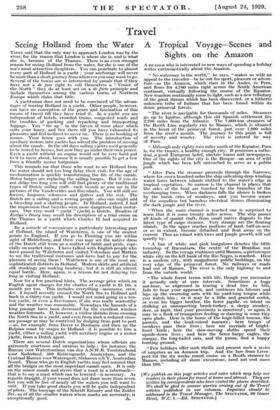Travel
Seeing Holland from the Water
TAINE said that the only way to approach London was by the river, for the reason that London is where she is, and is what
she is, because of the Thames. There is an even stronger reason for seeing Holland from the water, for she is one of the sea's most attractive daughters. You can penetrate to almost every part of Holland in a yacht ; your anchorage will never
be more than a short journey from wherever you may want to go. Several of the towns- are so intersected by canals that if they
have not a de jure right to call themselves a "Venice of the North" they do at least act on a de facto principle and include themselves among the various towns of Northern Europe which claim that title.
A yachtsman does not need to be convinced of the advan- tages of touring Holland in a yacht. Other people, however, can have no conception of the peace and fascination of this means of travel till they have tried it. In a yacht you are independent of hotels, crowded trains, congested roads and the troubles of packing and repacking and transporting luggage. You "tie up" in the haven of some place which suits your fancy, and live there till you have exhausted its pleasures and feel inclined to move on. There is no booking of rooms. Your house goes with you. The introduction of auxiliary motors into yachts has solved the problem of moving about the canals. In the old days sailing yachts used generally to be towed by horses, but now they go under their own power. Even a yacht without an engine would not be very hard put to it to move about, because it is usually possible to get a tow from a friendly motor bargeman.
This reminds me that those who want to see Holland from the water should not too long delay their visit, for the age of mechanization is quickly transforming the life of the canals. Motor barges are replacing the sailing barges. But if you do not delay too long you will still find plenty of the traditional types of Dutch sailing craft—such vessels as you see in the pictures of the Vandeveldes and Ruysdaels. You will still see boeiers, hoogaars, schouwen and (jotters and the rest. The Dutch are a sailing and a rowing people—also one might add a bicycling and a skating people. In Holland, indeed, I had the impression that bicycles were more dangerous than motor- cars. Our very word "yacht" (jacht) is Dutch. Readers of Evelyn's Diary may recall his description of a trial cruise on the Thames in a yacht which Charles II had acquired in Holland.
By a miracle of convenience a particularly interesting part of Holland, the island of Walcheren, is one of the nearest points to England. If you go to Flushing you are within sight of Middelburg, and there you may see the native dress of the Dutch still worn as a matter of habit and pride, espe- cially on market days. I have talked with English people who have passed by Walcheren and visited Volendam and Marken to see the traditional costumes and have had to pay for the pleasure of seeing them ! Walcheren is one of the most un- sophisticated districts in Holland. Modern skirts and artificial silk stockings are making headway, but it is still an almost equal battle. Here, again, is a reason for not delaying too long in visiting Holland.
Now for a few practical hints. The average price which an English agent charges for the charter of a yacht is 15 10s. a month per ton. This includes everything—insurance, crew, &c. I myself recently crossed the North Sea to Holland and back in a thirty-ton yacht. I would not mind going in a ten- ton yacht, or even a five-tonner, if she was really seaworthy and the weather was reasonable. Nowadays the hazards of a long passage have been decreased by the excellent wireless weather forecasts. If, however, a visitor shrinks from crossing the North Sea in a yacht, and even from such a reduced cross- sea passage as may be contrived by dodging from port to port —as, for example, from Dover to Boulogne and then up the Belgian coast by stages to Holland—it is possible to hire a yacht, either a sailing yacht with auxiliary engine or a motor yacht, from a Dutch agent.
There are several Dutch organizations whose officials are extremely courteous and anxious to help : for instance, the Bureau voor Watertoerisme van den A.N.W.B. Toeristenbond voor Nederland, 590 Keizersgracht, Amsterdam, and the Centraal Bureau voor Watersport, Sixhaven ofh Y, Amsterdam Noord. Those who go in English yachtsmay feel assured that all the bridges on the most important canals open. It is only on the minor canals and rivers that a mast in a tabernacle— that is to say a mast which can be lowered—is necessary. As regards draught, if your vessel does not draw 'more than seven feet you will be free of nearly all the waters you will want to visit. If you take good charts you will be quite independent of pilots. The buoyage of the Scheldt Estuary and the, Zuider Zee, as of all the smaller waters where marks are necessary, is






























 Previous page
Previous page